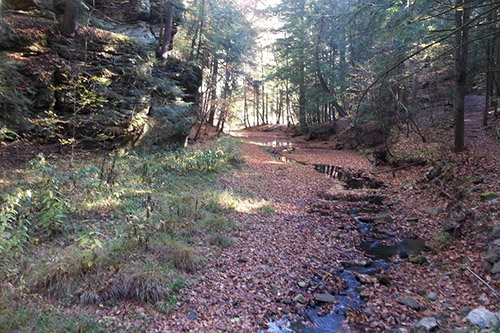The Primary Headwater (PHW) course trains individuals to use a set of methods (e.g., HHEI, HMFEI, salamanders) designed to assess the ecological condition of smaller streams. Primary Headwater (PHW) streams are usually less than 1.0 sq. mi., but not always. For these resources, the evaluation methods for biological and habitat assessments used on larger streams and rivers (e.g., IBI, ICI, QHEI) do not function to adequately assess PHW streams. In such small streams, the measures of quality used are the Headwater Habitat Evaluation Index (HHEI), macroinvertebrates based on identification to Family Level (HMFEI) and/or lowest taxonomy to genus/species level, and amphibian and headwater fish community assessments. Three general types of PHW streams exist based upon the biological communities present. For some purposes, only the habitat features (HHEI) are used for submission to regulatory agencies.
Day One: Classroom Training
The course starts with a full day of classroom instruction covering the science, principles, uses and protocols of the primary headwater assessments mentioned above. We will be using the 2020 Ohio EPA manual “Field Methods for Evaluating Primary Headwater Streams in Ohio (Version 4.1)” for instruction. This is available online at the Ohio EPA website or in the One Drive accessory information for this MBI course. The first part of the morning will be instructing trainees how to fill out the Headwater Habitat Evaluation Index (HHEI) field sheet. The training will also include bioassessment methods for invertebrate, salamander and headwater fish communities. Evaluation using both biological and habitat data in headwater streams will be thoroughly covered. Flow charts will be used based on the type of data collected to classify PHW streams into one of the three general categories. We also discuss the differences in Primary Headwater streams vs. Warmwater Habit (WWH) streams. The lab will be open for those interested in Identification of headwater invertebrates and vertebrates later in the day.
Day Two: Field Training
Participants will practice hands-on application of the PHW methods in local headwater streams. The Field training will cover protocols for the Headwater Habitat Evaluation Index (HHEI), the Headwater Macroinvertebrate Field Evaluation Index (HMFEI), salamander surveys and headwater fish sampling. Higher level methods of macroinvertebrate taxonomy and fish methods will be discussed. The last site of the day will include an HHEI test site which, if passed, trainees will be able to apply to the Ohio EPA Credible Data Program for an HHEI Level 2 Certification.
Results
Participants will leave the course with a strong understanding of primary headwater stream ecology and will know the protocols to conduct HHEI and biological assessment methods. Participants will also gain a strong knowledge of how to use the available data to properly classify headwater streams, and will receive a certificate documenting completion of the course*. Certification for the Ohio EPA HHEI Level 2 QDC will be discussed **.
Please Note:
The PHWH course is available at a discounted rate if you are also attending the QHEI course Monday and Tuesday of the same week. To register for both, you must proceed first to the corresponding QHEI course, register first for this, then select the PHWH Add-on.
* This course is eligible for Continuing Education Unit credits as certified by the Society of Wetland Scientists Professional Certification Program.
** This course is eligible for the HHEI Level 2 Certification from the Ohio EPA Credible Data Program (upon receiving a passing score at an HHEI test site).

